
Atlas F1 Senior Writer
The United States Grand Prix marked the halfway point of the 2004 18-race calendar. Atlas F1's Karl Ludvigsen reviews and rates the teams' performances in the first nine races of the year
Before we start it's worth remembering that if this were 1966 the season would already be over. Only nine championship Grands Prix were raced that year and in 1962. Ten were raced in the intervening years and in 1960, and in 1961 only eight. In those days there were, of course, a number of non-championship races for Grand Prix cars, a phenomenon now confined to the past. Nevertheless this reflection on the length and content of long-ago seasons gives us a sense of the intensity with which the Grand Prix wars are waged today.
This comparison also reminds us how much the current format of Formula One is biased toward the championships and away from the individual races. In 1966 the races ranged in length between 195 and 248 miles, while last year they were between 142 and 193 miles long. Needless to say, they take a lot less time to complete than they did in 1966! So a Grand Prix is still a Very Big Deal to a host nation, but nothing like the major event of the year that it was back in the 1960s.
Against that background, let's see how our ten teams are doing with the benefit of their first nine races of 2004. They're ranked in the order of their grades.
With nine races gone in an 18-race season, it's time to assess how well the teams are doing. We need to grade them now so they can see how they stand and what they have to do in order to be ranked better at season's end.
Points Scored: 142
Wins: 8
Poles: 6
DNFs: 1
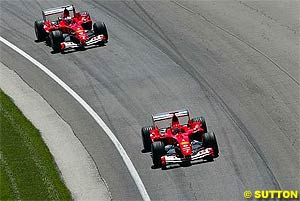 No other grade can be given. Ferrari have scored straight 'As' across the board so far in 2004. Their engines are the best of the best, their chassis grip both powerful and efficient, their strategy well up to standard and their drivers fully capable of implementing it. One of the team's drivers, Rubens Barrichello, is the sole starter among 20 to have an uninterrupted record of finishing. Only Michael's misjudgment in the Monte Carlo tunnel has marred a semi-season that must be described as impeccable.
No other grade can be given. Ferrari have scored straight 'As' across the board so far in 2004. Their engines are the best of the best, their chassis grip both powerful and efficient, their strategy well up to standard and their drivers fully capable of implementing it. One of the team's drivers, Rubens Barrichello, is the sole starter among 20 to have an uninterrupted record of finishing. Only Michael's misjudgment in the Monte Carlo tunnel has marred a semi-season that must be described as impeccable.
Points Scored: 58
Best position: 2nd
Poles: 1
DNFs: 4
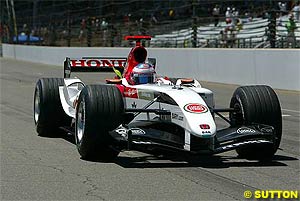 What a performance! BAR-Honda well deserve their B+ grade for the start of their season. In fact it would have been at least an A- had it not been for the spate of failures that struck Takuma Sato's car in Monaco, Germany and Canada. At last taking Formula One seriously, Honda has produced an engine that's trading punches with the best out there. As well, Geoff Willis's chassis is producing awesome grip in the twisty bits — fastest of all by a huge margin in Sector 2 of Indianapolis during the race. As David Richards has made crystal clear, the team can aim for a better grade by continuing the engine reliability that put Sato on the podium at Indy and also by better focusing this remarkable Japanese driver's ability.
What a performance! BAR-Honda well deserve their B+ grade for the start of their season. In fact it would have been at least an A- had it not been for the spate of failures that struck Takuma Sato's car in Monaco, Germany and Canada. At last taking Formula One seriously, Honda has produced an engine that's trading punches with the best out there. As well, Geoff Willis's chassis is producing awesome grip in the twisty bits — fastest of all by a huge margin in Sector 2 of Indianapolis during the race. As David Richards has made crystal clear, the team can aim for a better grade by continuing the engine reliability that put Sato on the podium at Indy and also by better focusing this remarkable Japanese driver's ability.
Points Scored: 66
Wins: 1
Poles: 1
DNFs: 4
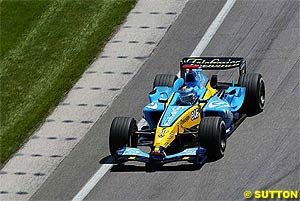 As a team Renault have achieved remarkably strong and balanced performance so far in 2004. They even scored a win in the race where engine power contributes the least, Monaco. That marks out the area where Renault must improve. Timings in Sector 3 at Indianapolis — that long haul of acceleration up the straight — show that Renault's record, second in the championship, is achieved in spite of a lack of horses. Their drivers are among the best, reliability is pretty good and, in spite of their paint job, the curvy car is downright gorgeous. The only area needing improvement is the engine, and we know Renault are no slouches in that department. I don't expect to award a higher grade this year, but next year is another story.
As a team Renault have achieved remarkably strong and balanced performance so far in 2004. They even scored a win in the race where engine power contributes the least, Monaco. That marks out the area where Renault must improve. Timings in Sector 3 at Indianapolis — that long haul of acceleration up the straight — show that Renault's record, second in the championship, is achieved in spite of a lack of horses. Their drivers are among the best, reliability is pretty good and, in spite of their paint job, the curvy car is downright gorgeous. The only area needing improvement is the engine, and we know Renault are no slouches in that department. I don't expect to award a higher grade this year, but next year is another story.
Points Scored: 15
Best position: 4th
Poles: 0
DNFs: 5
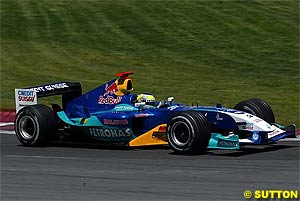 Quietly and efficiently, as is his style, Peter Sauber has been keeping on getting on, and with good results in proportion to his resources. That's an aspect I don't intend to overlook in this grading. Credits or debits are due in relation to the use that a team make of their money and means. Though far from the wealthiest of teams, Sauber have parlayed their combination of Ferrari-drive train with Ferrari-like chassis into five finishes in the points, including a fourth in Canada for that fine little driver Giancarlo Fisichella. Importantly, the team have shown signs of being able to improve during the season, with their new wind tunnel, instead of trailing off as they have in the past.
Quietly and efficiently, as is his style, Peter Sauber has been keeping on getting on, and with good results in proportion to his resources. That's an aspect I don't intend to overlook in this grading. Credits or debits are due in relation to the use that a team make of their money and means. Though far from the wealthiest of teams, Sauber have parlayed their combination of Ferrari-drive train with Ferrari-like chassis into five finishes in the points, including a fourth in Canada for that fine little driver Giancarlo Fisichella. Importantly, the team have shown signs of being able to improve during the season, with their new wind tunnel, instead of trailing off as they have in the past.
Points Scored: 36
Best position: 2nd
Poles: 1
DNFs: 7
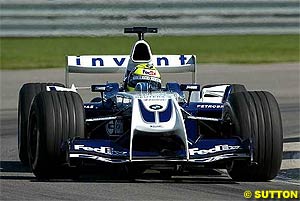 The most-hyped team for 2004 are floundering big time. Power isn't the problem; the BMW engines nearly matched the best in their dashes down Indy's straight. My only reservation is that BMW may still have to be dialling their engines back a bit more for the race than some of their rivals. As Frank Williams has said, the difficult bit is getting around the corners. This the BMW-Williamses are unwilling to do consistently enough for their drivers to make best use of their capabilities. To top it all, the disqualifications of the last two races have dropped their grade from B- to C+. On the good side: no team have a better chance to improve their form in the second half of the season.
The most-hyped team for 2004 are floundering big time. Power isn't the problem; the BMW engines nearly matched the best in their dashes down Indy's straight. My only reservation is that BMW may still have to be dialling their engines back a bit more for the race than some of their rivals. As Frank Williams has said, the difficult bit is getting around the corners. This the BMW-Williamses are unwilling to do consistently enough for their drivers to make best use of their capabilities. To top it all, the disqualifications of the last two races have dropped their grade from B- to C+. On the good side: no team have a better chance to improve their form in the second half of the season.
Points Scored: 1
Best position: 8th
Poles: 0
DNFs: 9
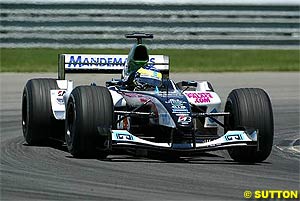 Considering the modest resources that Paul Stoddart's Minardi bring to the party, they are doing pretty well. Given that their driver cadre is not what it once was, and their Cosworth engines anything but the latest evolution, Minardi are carrying their battered banner with some considerable pride. Reliability hasn't been brilliant, with five dropouts from 18 races for mechanical reasons, but some better-funded teams haven't done any better. Well done, Minardi! You deserve more support.
Considering the modest resources that Paul Stoddart's Minardi bring to the party, they are doing pretty well. Given that their driver cadre is not what it once was, and their Cosworth engines anything but the latest evolution, Minardi are carrying their battered banner with some considerable pride. Reliability hasn't been brilliant, with five dropouts from 18 races for mechanical reasons, but some better-funded teams haven't done any better. Well done, Minardi! You deserve more support.
Points Scored: 8
Best position: 5th
Poles: 0
DNFs: 6
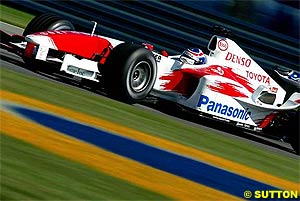 Speaking of resources, Toyota must be downgraded for failing to make good use of one of the biggest budgets in Formula One. Their cars have been finishing; only three retirements have been caused by mechanical failures. Most often, however, they've been in obscure double-digit positions — twice in 13th place. Indy's evidence would suggest that they're falling behind in the power race, and the Toyotas aren't making it up in the corners. The team's driver pairing can only be described as unconvincing. Don't expect a better full-term grade.
Speaking of resources, Toyota must be downgraded for failing to make good use of one of the biggest budgets in Formula One. Their cars have been finishing; only three retirements have been caused by mechanical failures. Most often, however, they've been in obscure double-digit positions — twice in 13th place. Indy's evidence would suggest that they're falling behind in the power race, and the Toyotas aren't making it up in the corners. The team's driver pairing can only be described as unconvincing. Don't expect a better full-term grade.
Points Scored: 5
Best position: 7th
Poles: 0
DNFs: 9
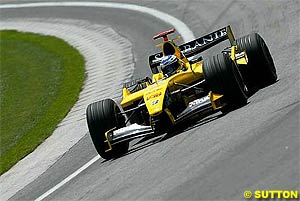 Here we have a team with one very good driver whose career in is jeopardy thanks to their underperformance. Poor Nick Heidfeld has suffered four retirements for mechanical reasons, matched only by McLaren's Kimi Raikkonen. When given a chance he works his way into the points, but he doesn't have that chance too often. Ford's contribution is nothing to get excited about; their engines were sluggards on the straight at Indy. We can forget about the contribution — save financial — by the other driver. Eddie Jordan claims to have arrested his team's slide to the bottom. The evidence that he has done so isn't too persuasive at half term.
Here we have a team with one very good driver whose career in is jeopardy thanks to their underperformance. Poor Nick Heidfeld has suffered four retirements for mechanical reasons, matched only by McLaren's Kimi Raikkonen. When given a chance he works his way into the points, but he doesn't have that chance too often. Ford's contribution is nothing to get excited about; their engines were sluggards on the straight at Indy. We can forget about the contribution — save financial — by the other driver. Eddie Jordan claims to have arrested his team's slide to the bottom. The evidence that he has done so isn't too persuasive at half term.
Points Scored: 3
Best position: 7th
Poles: 0
DNFs: 8
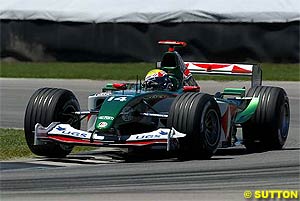 Here's another team who aren't doing justice to a driver that many rate among the best in the paddock. Mark Webber has only two points finishes and three mechanical DNFs to show for his 2004 season to date. Hopes were high for the swaggering Christian Klien, but he has naught to show for his first half-year. Jaguar aren't starring in any department. Even worse, team principal Tony Purnell never utters a sentence without moaning about his lack of cash. This has to be jangling the nerves of the people at Jaguar and Ford who have to justify the support he's getting. A besieged team that need a radical shakeup.
Here's another team who aren't doing justice to a driver that many rate among the best in the paddock. Mark Webber has only two points finishes and three mechanical DNFs to show for his 2004 season to date. Hopes were high for the swaggering Christian Klien, but he has naught to show for his first half-year. Jaguar aren't starring in any department. Even worse, team principal Tony Purnell never utters a sentence without moaning about his lack of cash. This has to be jangling the nerves of the people at Jaguar and Ford who have to justify the support he's getting. A besieged team that need a radical shakeup.
Points Scored: 17
Best position: 5th
Poles: 0
DNFs: 8
 Ron Dennis himself would award his team a failing half-term grade, as a judgement on their achievements in relation to their resources. His drivers are good, both Grand Prix winners. In power terms his engines aren't the worst out there by any means, though they do have an unfortunate propensity to explode. McLarens have finished only ten of the available 18 races. The chassis is woefully inconsistent, making the car 'unpredictable' as David Coulthard called his at Indy. I had my say after Imola on what I think is wrong at McLaren. Bigger changes than those made so far will be needed to pull this outfit out of their appalling slump.
Ron Dennis himself would award his team a failing half-term grade, as a judgement on their achievements in relation to their resources. His drivers are good, both Grand Prix winners. In power terms his engines aren't the worst out there by any means, though they do have an unfortunate propensity to explode. McLarens have finished only ten of the available 18 races. The chassis is woefully inconsistent, making the car 'unpredictable' as David Coulthard called his at Indy. I had my say after Imola on what I think is wrong at McLaren. Bigger changes than those made so far will be needed to pull this outfit out of their appalling slump.
About the author:
Long time columnist at Atlas F1, Karl Ludvigsen is an award-winning author and historian who managed racing programs for Fiat in America in the late 1970s and Ford of Europe in the early 1980s. He is the author of seven books about racing drivers and numerous books about classic racing cars and engines, all of which draw extensively on the many images in his Ludvigsen Library in Suffolk, England.
![]()
Contact the Author
Contact the Editor
Please Contact Us for permission to republish this or any other material from Atlas F1.
|
Volume 10, Issue 25
Atlas F1 Exclusive
Ann Bradshaw: Point of View
Articles
2004 Half-Term Report
Jenson Button: a Hakkinen or a Hill?
2004 US GP Review
2004 United States GP Review
Precious Time
Stats Center
Qualifying Differentials
SuperStats
Charts Center
Columns
The F1 Insider
Season Strokes
On the Road
Elsewhere in Racing
> Homepage |